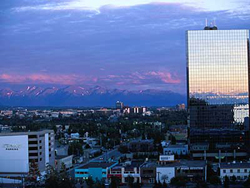Introduction
Natural History
"Diversity" describes Alaska. From
amphitheaters of granite spires to
old-growth, Sitka spruce forests to
sheltered shorelines and jagged fjords
to moose wading chest-deep in clear
waters, Alaska presents natural history
that stirs the imagination. Whether
you dream of whales, brown bears,
and bald eagles in their natural habitats
or long to feel the vastness of untrammeled
landscapes, Alaska travel offers you
the best nature-based journeys north
of Canada's Yukon Territory. Let our
experienced naturalists show you this
awe-inspiring place on our small-ship
cruises.
 Summers
in southeast Alaska, in the waters
near Icy Strait and Frederick Sound,
show off pods of humpback whales.
Humpbacks slap flippers and flukes
and feast through "bubble-net feeding"
in which the whales cast a net of
bubbles around their prey. Grab your
rain gear and watch as these huge
whales perform explosive half-breaches,
lifting their massive forms high above
the surface and then crashing with
a thunderous blow. A quick reflex
can capture such sights on film from
the ship's deck. Summers
in southeast Alaska, in the waters
near Icy Strait and Frederick Sound,
show off pods of humpback whales.
Humpbacks slap flippers and flukes
and feast through "bubble-net feeding"
in which the whales cast a net of
bubbles around their prey. Grab your
rain gear and watch as these huge
whales perform explosive half-breaches,
lifting their massive forms high above
the surface and then crashing with
a thunderous blow. A quick reflex
can capture such sights on film from
the ship's deck.
The water in southeast Alaska is cerulean
blue, cold, and chock-full of porpoises,
sea lions, harbor seals, and sea otters.
Hundreds of species of birds decorate
the coastline throughout the Inside
Passage. Nowadays, almost everywhere
you look you spot the once-endangered,
majestic American bald eagle, national
bird of the United States. Pay attention,
and you'll see the colorful puffin
with its crests or "horns" and its
bright orange beak, a favorite among
photographers.
From the Inside Passage, head to the
rivers and streams to watch black
bears and grizzly bears as they fish
for salmon. The color of these bears
ranges from cinnamon and blond to
blue-gray, black, tan, and brown.
Watch for the hump on the grizzly's
shoulders to identify this larger
bear from the smaller black bears.
Whales and bears are only half the
story of a trip that immerses travelers
in the spectacular geography and natural
and human history of the last frontier.
Cliff walls tower thousands of feet
above rocky beaches; giant trees seem
to tickle the glow of the sun. Botanists
can find edible plants and wild medicines
along the coastal forests and side
channels. Moose and other wildlife
roam freely. The barrage of images
and sensations overwhelms you in the
depths of Alaska's wildlands.
For more information on the natural
history of Alaska, see book selections
below.
History
An Athapaskan Indian story tells of a warrior who joined forces with a giant to attack a rival in Siberia. In the end, the rival won. The giant collapsed into the ocean, and his body created a bridge to what is now North America. The Athapaskans trekked across this fleshy ridge with herds of caribou in tow. Over time, the giant's body decomposed, but bones from his skeleton remained above the ocean's surface and formed the Aleutian Islands.
Scientists tell a different story. Some 30,000 to 40,000 years ago, in the Pleistocene period, low water levels in the Bering Sea revealed a land bridge connecting northeastern Asia to the North American continent. The 50-mile-long, 600-mile-wide spine of earth opened a passage for the nomadic peoples of the north to migrate south. Carbon dating on a caribou bone with a distinctive saw-toothed edge has revealed evidence of this from 27,000 years ago.
"Alaska" means "great land" or "mainland" and originated from the people of the Aleutian Islands. Alaska, the 49th and largest state in the Union (almost one-fifth the size of the lower 48), was granted statehood on January 3, 1959, by President Dwight D. Eisenhower. But the United States purchased the land from Russia on October 18, 1867, spearheaded by the U.S. Secretary of State, William H. Seward. Almost a century before, in 1784, a Russian fur trader settled the first non-native community in Alaska, Kodiak Island. Few paid attention to "Seward's Icebox," as Americans called it after the 1867 purchase. Then, in 1896, the Gold Rush brought waves of settlers to the frontier land when prospectors discovered gold in the Klondike of the Yukon Territory just over the border from Alaska. Over the next few years, thousands of men clambered on ships to Alaska and then traveled overland to the Klondike.
In 1899, diggers unearthed gold near Nome, followed in 1902 by a mother lode discovery close to Fairbanks. People followed the nuggets, and Alaska's population grew. In the early part of the 20th century, the U.S. military claimed bases at Valdez and Eagle. The U.S. stretched telegraph cables across the interior. Railroads connected many widely separated settlements. Copper deposits attracted miners, and thousands of independent explorers survived on their wits and wildlife. Single-track trails widened into pathways for covered wagons. Mail deliveries came more frequently. Settlers arranged limited self-government; in 1905 the capital switched from Sitka to Juneau.
Alaska's first delegate to Congress reached Washington, D.C., in 1906. Alaska became a U.S. territory in 1912. A year later, the first climbers gazed at Alaska from the top of the south peak of Denali (Mt. McKinley). The U.S. established Denali National Park in 1917.
To this day, Alaska maintains an irresistible, almost spellbinding, allure. Booms in fur, gold, salmon, and oil (1968 marked one of the biggest oil discoveries of all time at Prudhoe Bay on the Arctic coastal plain) crest and subside; each brings swells of entrepreneurs, adventurers, and explorers. They still come. Wildlife viewing, mountain climbing, bicycling, kayaking, hiking, fly fishing, camping, and nature-oriented tourism attract visitors year-round from the world over.
|

